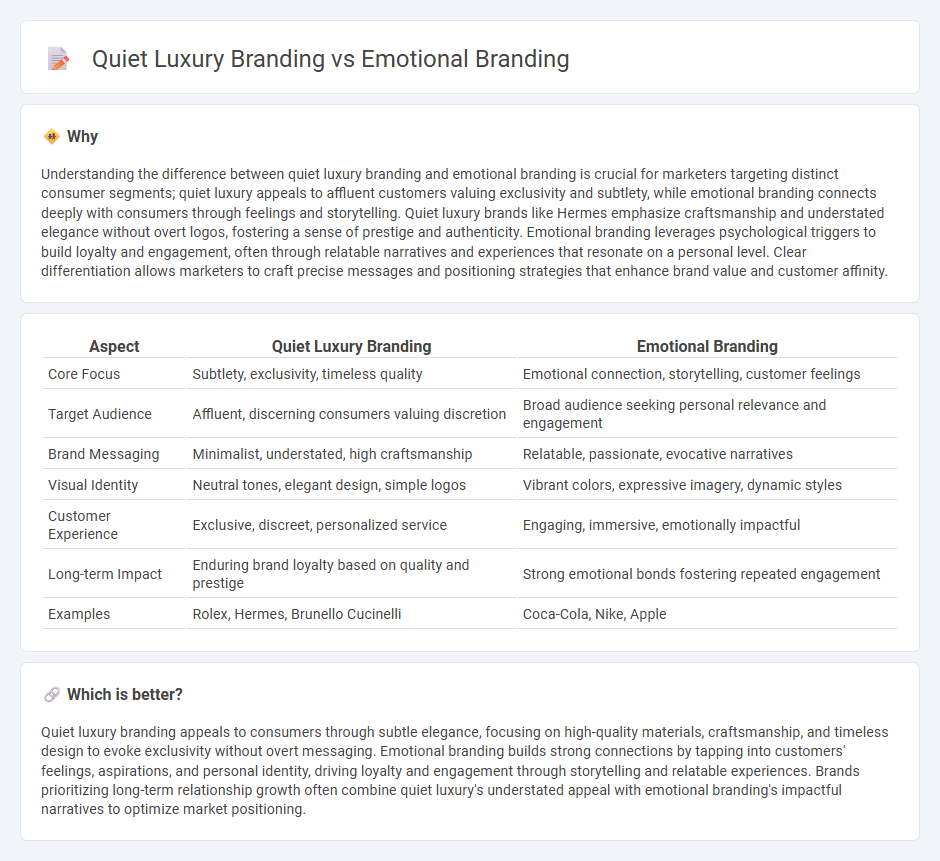
Quiet luxury branding focuses on subtlety, timeless elegance, and high-quality craftsmanship to attract discerning customers valuing exclusivity without ostentation. Emotional branding, in contrast, leverages storytelling and emotional connections to foster deep client loyalty and engagement. Explore how these distinct marketing strategies can elevate your brand's presence and consumer relationships.
Why it is important
Understanding the difference between quiet luxury branding and emotional branding is crucial for marketers targeting distinct consumer segments; quiet luxury appeals to affluent customers valuing exclusivity and subtlety, while emotional branding connects deeply with consumers through feelings and storytelling. Quiet luxury brands like Hermes emphasize craftsmanship and understated elegance without overt logos, fostering a sense of prestige and authenticity. Emotional branding leverages psychological triggers to build loyalty and engagement, often through relatable narratives and experiences that resonate on a personal level. Clear differentiation allows marketers to craft precise messages and positioning strategies that enhance brand value and customer affinity.
Comparison Table
| Aspect | Quiet Luxury Branding | Emotional Branding |
|---|---|---|
| Core Focus | Subtlety, exclusivity, timeless quality | Emotional connection, storytelling, customer feelings |
| Target Audience | Affluent, discerning consumers valuing discretion | Broad audience seeking personal relevance and engagement |
| Brand Messaging | Minimalist, understated, high craftsmanship | Relatable, passionate, evocative narratives |
| Visual Identity | Neutral tones, elegant design, simple logos | Vibrant colors, expressive imagery, dynamic styles |
| Customer Experience | Exclusive, discreet, personalized service | Engaging, immersive, emotionally impactful |
| Long-term Impact | Enduring brand loyalty based on quality and prestige | Strong emotional bonds fostering repeated engagement |
| Examples | Rolex, Hermes, Brunello Cucinelli | Coca-Cola, Nike, Apple |
Which is better?
Quiet luxury branding appeals to consumers through subtle elegance, focusing on high-quality materials, craftsmanship, and timeless design to evoke exclusivity without overt messaging. Emotional branding builds strong connections by tapping into customers' feelings, aspirations, and personal identity, driving loyalty and engagement through storytelling and relatable experiences. Brands prioritizing long-term relationship growth often combine quiet luxury's understated appeal with emotional branding's impactful narratives to optimize market positioning.
Connection
Quiet luxury branding and emotional branding intersect through their shared focus on creating deep, personal connections with consumers by emphasizing understated elegance and authenticity. Quiet luxury leverages minimalistic design and subtle quality cues to evoke feelings of exclusivity and refinement, aligning closely with emotional branding's goal to build trust and loyalty through meaningful experiences. By intertwining these strategies, brands can foster strong emotional resonance that enhances perceived value and cultivates long-term consumer relationships.
Key Terms
**Emotional Branding:**
Emotional branding centers on forging deep, meaningful connections between consumers and brands by appealing to feelings and personal values, enhancing customer loyalty and advocacy. It employs storytelling, sensory experiences, and relatable narratives to evoke emotions such as trust, happiness, or nostalgia, thereby differentiating the brand in competitive markets. Discover how emotional branding strategies can transform customer engagement and build lasting brand equity.
Storytelling
Emotional branding leverages evocative storytelling to forge deep connections with consumers by appealing to their feelings, memories, and values. Quiet luxury branding employs subtle, refined narratives that emphasize exclusivity, craftsmanship, and understated elegance without ostentatious displays. Explore how these distinct storytelling approaches shape consumer perception and brand loyalty in different market segments.
Brand Loyalty
Emotional branding fosters deep brand loyalty by creating strong, meaningful connections between consumers and brands through storytelling and sensory experiences. Quiet luxury branding emphasizes exclusivity and subtlety, attracting loyal customers who value understated elegance and high-quality craftsmanship over overt marketing. Explore how these distinct strategies cultivate brand loyalty in unique ways.
Source and External Links
Emotional branding - Wikipedia - Emotional branding involves building brands that appeal directly to consumers' emotional states and aspirations to create strong, lasting bonds comparable to love or companionship, moving beyond simple product features to trust and experience.
Emotional Branding: Benefits & Examples | Ramotion Agency - Emotional branding uses marketing techniques that trigger consumer emotions to establish strong connections, enhance loyalty and decision-making, exemplified by campaigns like Coca-Cola's "Share a Coke" that personalize customer experience.
Emotional Branding: How to Win Hearts and Minds | purpleplanet - Effective emotional branding focuses on understanding the audience's struggles, telling compelling stories, and addressing social responsibility to connect deeply with consumers beyond product features.
 dowidth.com
dowidth.com